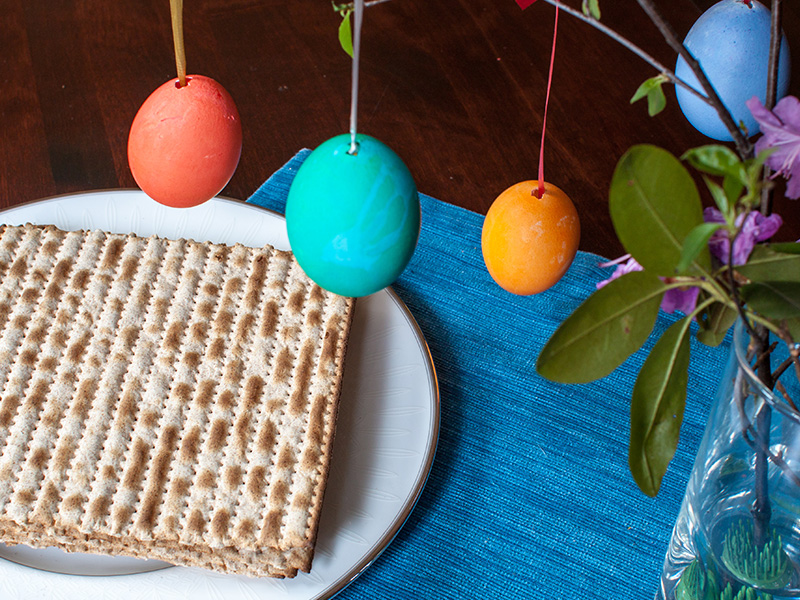Here are some figures to chew on until the Seders arrive:
- The Seder meal alone, without the four cups of wine, desserts, nuts and other fattening foods, can total 1,700 calories.
- one matzah has 140 calories, equivalent to two pieces of bread
- four standard wineglasses of grape juice have 680 calories
- that Passover staple, the walnut, has 694 calories per 100 grams
- and the average Israeli gains one to three kilograms over Passover.
Do you think you’re so different on this side of the Atlantic? Whether you’ve decided to cut down on the fat or calories, or are vegetarian or diabetic, there are plenty of Passover dishes you can enjoy while watching what you eat.
Nutritionist Fran Berkoff recommends “a good non-stick pan, some chicken broth or vegetable broth for sautéing or as a base for salad dressings. If a recipe calls for a half-cup of oil, try cutting to a third and, if this works, try cutting down even further. Substitute unsaturated oils for chicken fat in traditional recipes and perk up flavours with lemon juice and/or generous amounts of fresh herbs. Instead of piling lots of butter on your matzah, try some jam.”
You can escape the mega-oil mega-egg fat-laden dishes if you cook creatively. Even Philip Goldwasser’s mother doesn’t buy 20 dozen eggs like she did when Philip was growing up. How does she do it? “First, use less eggs!,” says Philip. “Any dish that calls for eggs can usually be lessened by one egg. Not all dishes, but most. Another way to deal with this is to substitute egg white for eggs. Let’s say that you have a recipe that calls for four eggs. You can use 2 whole eggs and 2 egg whites.”
Are you confused by the vast array of matzahs now available including whole-wheat, high-fibre, spelt, organic, shmura and thin? As Bonnie Taub-Dix explains, “Be careful not to be fooled by deceptive labels. For example, ‘thin matzo’ doesn’t automatically result in a thin bod when you take a closer look at the label, which shows 100 calories per piece, 2 grams of protein and only 1 gram of fibre. In comparison, another box called “light whole-wheat bran matzo” weighed in at 85 calories, with 3.6 grams of protein and 5.4 grams of fibre. Be on the lookout for the best of the bunch, called ‘light high-fibre,’ which contained only 78 calories, 3.2 grams of protein and a whopping 6.9 grams of fibre per board. That’s sure to create a moving experience this holiday.”
Tips:
- Fasting before a festive meal such as the Seder is not a good idea, says Israeli nutritionist Sigal Frishman, since arriving at the table with an empty stomach leads to overeating
- Don’t try to totally deprive yourself of the traditional comfort foods of Pesach. Just eat them in small portions. Give yourself permission to indulge a little bit, it is all about portion control.
- Know your fats: On Passover, we use many foods containing healthy fats: avocado, nuts and almonds, almond flour and more. Foods from this food group form an important source of energy, provide fatty acids essential for the body, help in the absorption of fat-soluble vitamins and contribute to the health of the skin and hair.
- And here’s my favourite tip: At the Seder itself, wear clothing that is a bit tight around the waist so one will feel full before they actually are.
And if you need a spiritual boost to keep your eating habits in check, Rabbi Boruch Leff suggests remembering why we eat matzah in the first place. “The Sages describe the lower, animalistic part inside of us, the yetzer hara, as the leaven in the dough. This is why the Torah ascribes such great significance to avoiding chametz on Passover and eating matzah instead. Matzah is eaten because God wants us to avoid the power of the evil inclination present in the leaven of chametz….
“Passover is the annual holiday when are supposed to weaken our physical desires and lusts for the rest of the year. It’s the time for us to take a break from our regular eating habits and work on limiting our strong desire for food which can so easily get of hand.”







